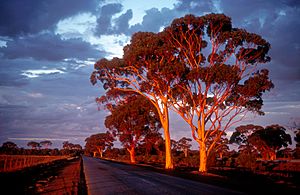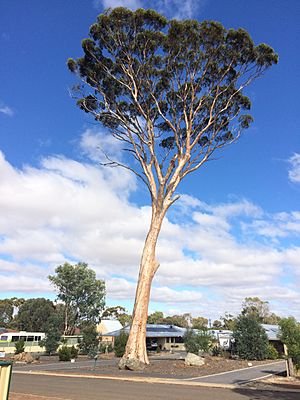Salmon gum facts for kids
Quick facts for kids Salmon gum |
|
|---|---|
 |
|
| Salmon Gums at sunset near Bruce Rock W.A. | |
| Scientific classification | |
| Genus: |
Eucalyptus
|
| Species: |
salmonophloia
|
The Eucalyptus salmonophloia, commonly known as salmon gum, is a special tree found only in Western Australia. It's a small to medium-sized tree. It has smooth bark and long, narrow adult leaves. Its flowers are creamy white, and its fruit looks like a small, woody cup. The Noongar people also call this tree wurak or weerluk.
Contents
What the Salmon Gum Looks Like
The Salmon gum tree typically grows between 4 and 30 meters (about 13 to 98 feet) tall. It has smooth, pale grey bark that peels off in flakes. When the old bark comes off, it shows new bark underneath that is a pretty salmon colour, especially in summer.
Young Salmon gum plants have dull green leaves that are shaped like an egg or a wide spear. These leaves are about 70 to 90 mm long and 12 to 30 mm wide. They have a small stem called a petiole.
Adult leaves are shiny green on both sides. They are narrow and spear-shaped or slightly curved. They grow to be about 60 to 120 mm long and 6 to 17 mm wide. Each adult leaf also has a petiole, which is 7 to 20 mm long.
The tree's flower buds grow in groups of nine to thirteen. They are found where the leaves meet the stem. Each group of buds is on a stalk called a peduncle, which is 4 to 13 mm long. The individual buds are on smaller stalks called pedicels, about 2 to 4 mm long.
Mature buds are oval or round, about 4 to 7 mm long and 3 to 4 mm wide. The Salmon gum flowers from August to December, and its flowers are creamy white.
After flowering, the tree produces woody, cup-shaped fruits called capsules. These capsules are about 3 to 5 mm long and 4 to 5 mm wide. They have parts that stick out but are easy to break. The fruits usually stay on the tree until the next summer or even longer. Each capsule holds many tiny seeds.
The Salmon gum looks a lot like another tree called Eucalyptus salicola. Both trees have a similar shape and salmon-coloured bark. However, you can tell the Salmon gum apart by its egg-shaped young leaves and round buds. Eucalyptus salicola can also grow in salty soil, which the Salmon gum cannot.
How the Salmon Gum Got Its Name
The scientific name for the Salmon gum, Eucalyptus salmonophloia, was first officially described in 1878. A botanist named Ferdinand von Mueller wrote about it in his book Fragmenta Phytographiae Australiae. He used samples collected by Ernest Giles near Victoria Springs.
The "salmonophloia" part of its name comes from the salmon-coloured bark of the tree. It's a way to describe its unique look. The local Noongar people have their own names for the tree: wurak or weerluk.
Where the Salmon Gum Grows
The Salmon gum grows in large woodland areas in Western Australia. You can find it in the southern Wheatbelt and the Goldfields-Esperance region.
In the western parts of its range, there are only small groups of these trees left. This is because much of the land has been cleared for farming. These groups stretch from areas like York and Northam down to Jerramungup.
Further east, the Salmon gum woodlands are much less disturbed. They extend as far east as Cundeelee, north to the Mt Gibson area, and south to Salmon Gums.
The Salmon gum is often the main tree in these woodlands, forming a thin upper layer. It grows in wide valleys, plains, and low hills. It can survive in places that get as little as 250 mm (about 10 inches) of rain each year. It prefers alkaline (not acidic) loamy soils, red clay, or red sandy soils, sometimes with gravel. In western areas, it grows in granite soils, and in eastern areas, it grows in soils with lime.
Many other plants grow alongside the Salmon gum. Some of these include other eucalyptus trees like Eucalyptus salubris, Eucalyptus longicornis, Eucalyptus wandoo, and Eucalyptus loxophleba. There are also many smaller plants and shrubs that grow beneath them.
Life Cycle of the Salmon Gum
This type of Eucalyptus tree is known to live for a very long time, often more than 150 years!
How People Use Salmon Gum
The wood from the Salmon gum is very strong and lasts a long time. Because of this, it has been used to make railway sleepers (the wooden beams that support train tracks) and supports for mining shafts.
In the past, the mining industry cut down a lot of Salmon gum trees. They used the wood for building and as a fuel source. This tree, along with two types of acacia, helped the goldfields in Western Australia to develop. In 1922, the state's forest department said that Salmon gum timber was the second strongest in Australia.
Today, it is still commonly used for wood fires because it makes excellent firewood. It's also a great tree for helping damaged land recover and for stopping soil from washing away. This is because it can handle dry conditions, resist frost, grows quickly, and can grow in poor soils.
The inner wood of the Salmon gum is fine, dense, and has a reddish to dark red-brown colour. It can be used to make beautiful furniture, flooring, wall panels, craft items, and even parts of musical instruments like flutes. Craftsmen like working with this wood because it's good for turning, machining, drilling, and gluing.
Beekeepers also like the Salmon gum because its flowers produce honey from December to March.
Images for kids
See also
 In Spanish: Eucalyptus salmonophloia para niños
In Spanish: Eucalyptus salmonophloia para niños







